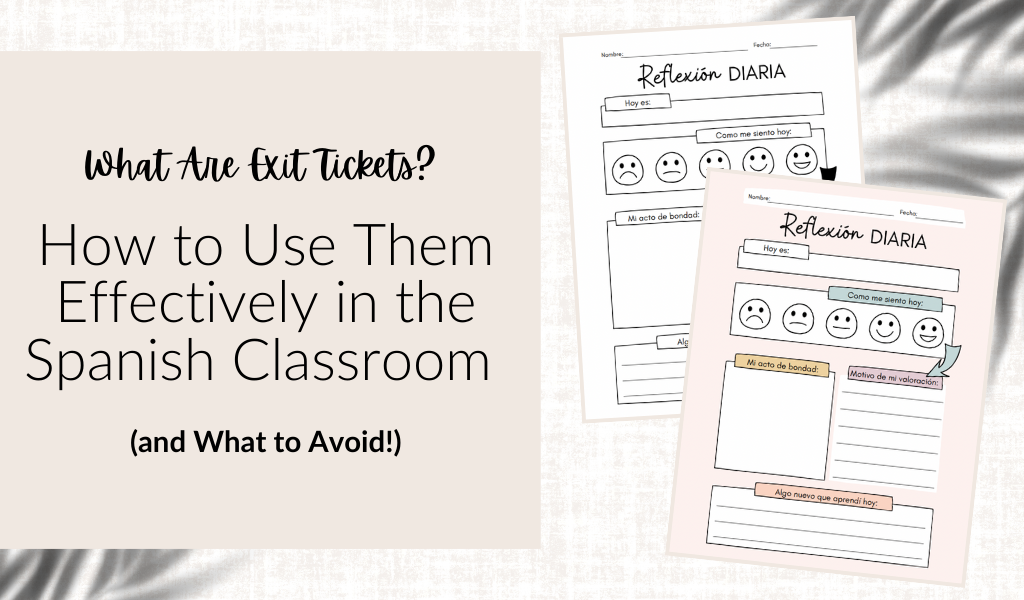Hey there, Joyful Journey Makers! 
What Are Exit Tickets? 
Exit tickets are quick, end-of-class assessments that allow students to reflect on their learning and give teachers insight into how well the lesson was understood. They’re typically short, requiring only a few minutes to complete, but they provide invaluable feedback that helps shape future lessons. By asking questions about what students learned, how they felt, or what they found confusing, exit tickets offer a snapshot of where your students are in their learning journey.
How Do Exit Tickets Support Formative Assessment?
Formative assessments are those assessments that happen during the learning process, not at the end. They provide real-time insights into students’ understanding and help teachers adjust instruction to meet their needs (Black & Wiliam, 2009). Exit tickets are a form of formative assessment because they give teachers immediate feedback on what’s working and what needs to be reviewed.
Here’s why formative assessments—especially exit tickets—are so essential:
Common Mistakes to Avoid with Exit Tickets
- Asking Vague Questions: “How do you feel about today’s lesson?” is too broad. Instead, ask more specific questions like, “What’s one new thing you learned today?”
- Not Reviewing Them: If you’re not looking at the exit tickets, they’re just a time-filler. Make sure you actually review the feedback and use it to adjust future lessons.
- Too Many Questions: Keep it simple—two to three questions max. Exit tickets should be quick and easy, not an end-of-class quiz.
3 Easy Ways to Use Exit Tickets in Any Class
- Content Check: Ask students to write down one thing they learned and one thing they’re still confused about. This helps you gauge overall understanding and spot any knowledge gaps.
- Reflection: Have students reflect on their participation that day. Did they ask questions? Did they stay engaged? This helps foster self-assessment and accountability.
- Prediction: Ask students to predict what they’ll be learning in the next class based on what they learned today. It’s a fun way to see who’s paying attention and help them make connections between lessons.
Why Exit Tickets Are Perfect for Formative Assessment and Self-Reflection
Exit tickets aren’t just about collecting data—they’re also about encouraging students to reflect on their learning. By asking students to think critically about what they’ve learned and how they’ve engaged with the material, you’re helping them develop metacognitive skills, which are key to becoming independent learners (Brown, Roediger III, & McDaniel, 2014). Plus, when students self-assess, they’re more likely to take ownership of their learning.
Daily Reflection Thoughtful Exit Ticket in Spanish
Introducing the Daily Reflection Thoughtful Exit Ticket
Now that we’ve covered why exit tickets are so powerful, let me introduce you to my Daily Reflection Thoughtful Exit Ticket. This activity is designed to not only help students reflect on their learning but also on their emotions and actions throughout the day. It’s all about fostering self-awareness and encouraging kindness and mindfulness in the classroom. Here’s what’s included:
- Spanish Reflection Sheet: A simple format that asks students to reflect on their day in Spanish, including how they feel, acts of kindness they’ve witnessed or performed, and something new they’ve learned.
- Full-Color and Black & White Versions: Choose what works best for your classroom!
- Teacher Instructions: Everything you need to seamlessly integrate this exit ticket into your daily routine.
3 Fun Ways to Use This Exit Ticket in Your Spanish Classroom
- End-of-Day Reflection: Use the exit ticket at the end of the day to help students wind down and reflect on their learning and behavior. This fosters a calm, reflective classroom environment and gives you insight into how students are feeling.
- Weekly Review: Collect the reflection sheets at the end of the week and have a one-on-one chat with students who may need extra support. It’s a great way to build a deeper connection with your students and provide individualized feedback.
- Self-Reflection Journal: Encourage students to keep their reflection sheets as part of a journal. At the end of each month, have them review their reflections to track their growth in both language and social-emotional learning.
3 Key Tips for Success
- Keep It Simple: Don’t overwhelm students with too many questions. Stick to 2-3 targeted prompts that encourage reflection and self-assessment.
- Consistency Is Key: Make exit tickets a regular part of your routine so students get used to reflecting on their learning.
- Use the Feedback: Always review the tickets and use the information to adjust your teaching. Students will know you care when you respond to their reflections.
The Gist of it All
Exit tickets are a quick, easy, and highly effective way to engage students in reflection and give you valuable feedback for your lesson planning. The Daily Reflection Thoughtful Exit Ticket takes things up a notch by encouraging students to think about their emotions, actions, and learning in Spanish, all while fostering self-awareness and kindness.

Resources
Black, P., & Wiliam, D. (2009). Developing the theory of formative assessment. Educational Assessment, Evaluation and Accountability, 21(1), 5-31.
Brown, P. C., Roediger III, H. L., & McDaniel, M. A. (2014). Make it stick: The science of successful learning. Harvard University Press.
Hattie, J., & Timperley, H. (2007). The power of feedback. Review of Educational Research, 77(1), 81-112.



